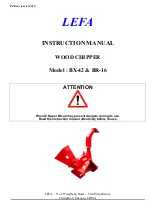
JOB DATA:
CHILLER MODEL NO. _________________ CHILLER MODEL NO. _______________________
NO. OF UNITS ________________________ NO. OF UNITS ______________________________
PRODUCT DRAWING
CONTRACTOR _______________________
PURCHASER ____________________________________________
ORDER NO. _________________________
JOB NAME ______________________________________________
YORK CONTRACT NO. _________________
LOCATION _____________________________________________
YORK ORDER NO. ____________________
ENGINEER ______________________________________________
REFERENCE
DATE ________
APPROVAL
DATE ________
CONSTRUCTION
DATE ________
NEW RELEASE
Form 155.21-W2 (1209)
WIRING DIAGRAM
FIELD CONTROL MODIFICATIONS
MODEL YIA CHILLERS (STYLE D)
Chiller design allows for ease of interfacing with Energy
Management Systems (EMS). The OptiView™ Control
Center includes unit status contacts, provisions for re‑
mote control inputs and provisions for remote setpoint
reset of leaving chilled liquid temperature and current
limit for EMS interfacing.
Five sets of unit status contacts are factory furnished
through a field wiring terminal board in the Optiview
Control Center. Each set of contacts are single pole,
normally open, rated at 5 amperes resistive at 240VAC.
Chiller status contacts are provided for unit:
• Remote Mode Ready to Start – See
Fig. 3.
• Cycling Shutdown – See
Fig. 4.
• Safety Shutdown – See
Fig. 5.
• Run (System Operating) – See
Fig. 6.
• Anticipatory/Alarm – See
Fig. 7.
Four sets of inputs are available to the EMS, allowing
for remote control of unit operation. input device contact
rating shall be 5 milliamperes at 115VAC. Field wiring
terminal board (TB4) in the OptiView™ Control Center
permits connection for the following operations:
• Remote Stop Contacts – See
Fig. 8.
• Remote Start Contacts – See
Fig. 8.
• Remote/Local Cycling Devices – See
Fig. 9.
• Multi-unit sequence – See
Fig
. 10.
1. The OptiView™ Control Center has a program
‑
mable time clock function as a standard feature
with holiday capability. This offers one preset au
‑
tomatic Start‑Stop per day on a seven day calendar
basis with the ability to program a single additional
holiday start and stop time up to a week in advance.
Chilled water pump control contacts (see Note 13)
are also provided, allowing for efficient automatic
operation of the chilled water pump to reduce en‑
ergy. Two chilled water pump operating modes are
available via the CHW PUMP programming dip
switch (position 8 of SW1) on the Microboard.
With the switch in the OFF position, the chilled
water pump operates for 30 seconds prior to chiller
start, during chiller operation, coastdown, and LWT
cycling shutdowns. With the switch in the ON posi
‑
tion, the chilled water pump operates as above plus
it operates during MULTI-UNIT and REMOTE/
LOCAL cycling shutdowns.
2. The Johnson Controls E-Link Gateway Card may
be interfaced with the chiller OptiView™ Control
Center to provide unified chiller plant system
control. The owners BAS System directly com
‑
municates with the OptiView™ Control Center via
the E-Link Gateway Card which may be installed
in the Control Center. Temperatures, pressures,
safety alarms and cycling information known to
the OptiView™ Control Center are then available
to the owners BAS network for integrated chiller
plant control, data logging, and local and remote
operator displays. The E-Link Gateway Card also
allows the BAS network to start, stop, and reset the
chiller’s leav ing chilled water and remote load set‑
points. The E-Link may be configured for BAC-net,
MS/TP, Mod-Bus RTU, N2 Metasys and Lonworks
network protocols.
ENERGY MANAGEMENT SYSTEMS


































